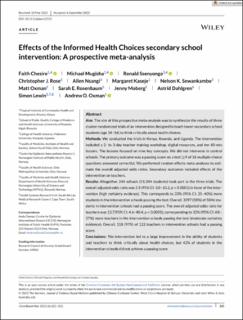| dc.contributor.author | Chesire, Faith Chelagat | |
| dc.contributor.author | Mugisha, Michael | |
| dc.contributor.author | Ssenyonga, Ronald | |
| dc.contributor.author | Rose, Christopher James | |
| dc.contributor.author | Nsangi, Allen | |
| dc.contributor.author | Kaseje, Margaret | |
| dc.contributor.author | Sewankambo, Nelson K. | |
| dc.contributor.author | Oxman, Matt | |
| dc.contributor.author | Rosenbaum, Sarah Ellen | |
| dc.contributor.author | Moberg, Jenny Olivia Jenkins | |
| dc.contributor.author | Dahlgren, Astrid | |
| dc.contributor.author | Lewin, Simon Arnold | |
| dc.contributor.author | Oxman, Andrew David | |
| dc.date.accessioned | 2023-11-30T07:53:30Z | |
| dc.date.available | 2023-11-30T07:53:30Z | |
| dc.date.created | 2023-10-02T14:53:14Z | |
| dc.date.issued | 2023 | |
| dc.identifier.citation | Journal of Evidence-Based Medicine (JEBM). 2023, 16 (3), 259-321. | en_US |
| dc.identifier.issn | 1756-5383 | |
| dc.identifier.uri | https://hdl.handle.net/11250/3105313 | |
| dc.description.abstract | Aim: The aim of this prospective meta-analysis was to synthesize the results of three
cluster-randomized trials of an intervention designed to teach lower-secondary school
students (age 14–16) to think critically about health choices.
Methods: We conducted the trials in Kenya, Rwanda, and Uganda. The intervention
included a 2- to 3-day teacher training workshop, digital resources, and ten 40-min
lessons. The lessons focused on nine key concepts. We did not intervene in control
schools. The primary outcome was a passing score on a test (≥9 of 18 multiple-choice
questions answered correctly). We performed random effects meta-analyses to esti-
mate the overall adjusted odds ratios. Secondary outcomes included effects of the
intervention on teachers.
Results: Altogether, 244 schools (11,344 students) took part in the three trials. The
overall adjusted odds ratio was 5.5 (95% CI: 3.0–10.2; p < 0.0001) in favor of the inter-
vention (high certainty evidence). This corresponds to 33% (95% CI: 25–40%) more
students in the intervention schools passing the test. Overall, 3397 (58%) of 5846 stu-
dents in intervention schools had a passing score. The overall adjusted odds ratio for
teachers was 13.7(95% CI: 4.6–40.4; p < 0.0001), corresponding to 32% (95% CI: 6%–
57%) more teachers in the intervention schools passing the test (moderate certainty
evidence). Overall, 118 (97%) of 122 teachers in intervention schools had a passing
score.
Conclusions: The intervention led to a large improvement in the ability of students
and teachers to think critically about health choices, but 42% of students in the
intervention schools did not achieve a passing score. | en_US |
| dc.language.iso | eng | en_US |
| dc.rights | Attribution-NonCommercial-NoDerivatives 4.0 Internasjonal | * |
| dc.rights.uri | http://creativecommons.org/licenses/by-nc-nd/4.0/deed.no | * |
| dc.title | Effects of the Informed Health Choices secondary school intervention: A prospective meta-analysis | en_US |
| dc.type | Peer reviewed | en_US |
| dc.type | Journal article | en_US |
| dc.description.version | publishedVersion | en_US |
| cristin.ispublished | true | |
| cristin.fulltext | original | |
| cristin.qualitycode | 1 | |
| dc.identifier.doi | 10.1111/jebm.12552 | |
| dc.identifier.cristin | 2181005 | |
| dc.source.journal | Journal of Evidence-Based Medicine (JEBM) | en_US |
| dc.source.volume | 16 | en_US |
| dc.source.issue | 3 | en_US |
| dc.source.pagenumber | 259-321 | en_US |
| dc.relation.project | Norges forskningsråd: 69006 | en_US |
| dc.relation.project | Norges forskningsråd: 284683 | en_US |

